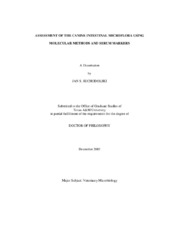| dc.description.abstract | Previous studies examining the canine intestinal microflora have focused on
cultivation of bacteria from intestinal content. Recently, it has been recognized that the
majority of bacteria cannot be identified using standard culture techniques. The aim of
this study was to describe the composition and dynamics of the canine intestinal
microflora using molecular methods based on identification of the 16S ribosomal DNA
(16S rDNA) and to evaluate the clinical use of a 13C-glycocholic acid blood test (13CGCBT)
as a serum marker for small intestinal bacterial biomass. Intestinal content was
obtained from healthy dogs and the microflora was characterized in different
compartments of each dog by denaturing gradient gel electrophoresis (DGGE) and
comparative 16S rDNA analysis. A 13C-glycocholic acid blood test (13C-GCBT) was
developed as a marker for small intestinal bacterial biomass and the influence of tylosin
administration on the 13C-GCBT, serum concentrations of cobalamin, folate, and
unconjugated cholic acid (SUCA) was evaluated. There was marked variation in DGGE
profiles between individual dogs and also between different intestinal compartments
within dogs. DGGE profiles from duodenal juice samples collected endoscopically at
different time-points varied within individuals, possibly due to variations over time or a
slight variation in sampling location. Direct sequencing revealed 106 individual 16S
rDNA sequences. Forty-two sequences showed less than 98% similarity to described
sequences in public databases and may constitute previously uncharacterized bacterial species. Serum folate concentrations, SUCA, and the cumulative percent dose/min of 13C
administered as 13C-glycocholic acid (CUMPCD) increased significantly following
tylosin administration (p<0.01). The results indicate that dogs have a complex intestinal
microflora with marked differences between individual dogs. Different intestinal
compartments appear to host a unique microflora and the assessment of a fecal sample
does not yield accurate information about the composition of the microflora in proximal
compartments of the gut. The intestine harbors many previously uncharacterized
bacterial species. The clinical significance of these uncharacterized intestinal bacterial
species needs to be further investigated in dogs with gastrointestinal disease. Increased
serum folate, SUCA, and CUMPCD in the 13C-GCBT suggest that, in the dogs described
here, tylosin administration increased the biomass of organisms carrying out these
metabolic functions. | en |


